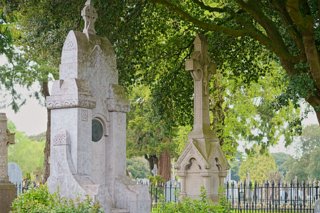NEAR THE MAIN GATE AND THE MUSEUM
While I typically enter the cemetery via the Botanic Gardens and exit by the old gate near the Gravediggers Pub, I occasionally photograph the area near the main gate or the museum.
Glasnevin Cemetery is renowned for its historically notable monuments and for being the final resting place of many of Ireland's most prominent national figures. These include the graves of Daniel O'Connell, Charles Stewart Parnell, Michael Collins, Éamon de Valera, Arthur Griffith, Maude Gonne, Kevin Barry, Roger Casement, Constance Markievicz, Seán MacBride, Jeremiah O'Donovan Rossa, James Larkin, Brendan Behan, Christy Brown, and Luke Kelly of the Dubliners.
Among the most visited sites in Glasnevin is the grave of Michael Collins, the nationalist leader killed in the Irish Civil War in 1922. At least 183 soldiers of the Irish Free State were buried around him, their names recorded on a memorial surrounding Collins' grave in 1967.
A controversial point in the cemetery's history is the 1993 discovery of a mass grave, belonging to a Magdalene laundry, an institution used to house "fallen women." After the convent that operated the laundry sold the land, remains were cremated and controversially reburied in a mass grave at Glasnevin, the cost shared between the developer and the Sisters from the convent.
The cemetery offers a fascinating glimpse into the evolution of death monuments in Ireland over the last 200 years. Styles changed from the austere, simple stone erections of the period up until the 1860s, to elaborate Celtic crosses during the nationalistic revival from the 1860s to the 1960s, then to the plain Italian marble common in the late 20th century.
The main part of the cemetery is enclosed by a high wall and watchtowers, a design specifically intended to deter bodysnatchers who were active in Dublin in the 18th and early 19th centuries. Packs of bloodhounds roamed the cemetery at night for added security.
In 2009, Glasnevin Trust, with the Commonwealth War Graves Commission (CWGC), began marking graves of Irish service personnel who served in the Commonwealth forces during the two world wars. Their names appear on two memorials rededicated and relocated in 2011 near the main entrance. As of July 2019, 215 service personnel of the Commonwealth of both wars have been identified as buried here. A Cross of Sacrifice was also erected during a joint Irish-British commemoration for the First World War centenary.
Glasnevin notably allowed stillborn babies to be buried in consecrated ground, in an area called the Angels Plot.
Within the cemetery grounds, Glasnevin Trust built a crematorium in 1982, used since by people of various religious denominations who wished to be cremated.
A highlight of the cemetery is the Glasnevin Trust Museum, designed by A&D Wejchert & Partners Architects and opened in 2010. The museum includes a café.
The cemetery runs tours, welcomes educational groups, and offers support for genealogists and those researching family history.
Glasnevin Cemetery is renowned for its historically notable monuments and for being the final resting place of many of Ireland's most prominent national figures. These include the graves of Daniel O'Connell, Charles Stewart Parnell, Michael Collins, Éamon de Valera, Arthur Griffith, Maude Gonne, Kevin Barry, Roger Casement, Constance Markievicz, Seán MacBride, Jeremiah O'Donovan Rossa, James Larkin, Brendan Behan, Christy Brown, and Luke Kelly of the Dubliners.
Among the most visited sites in Glasnevin is the grave of Michael Collins, the nationalist leader killed in the Irish Civil War in 1922. At least 183 soldiers of the Irish Free State were buried around him, their names recorded on a memorial surrounding Collins' grave in 1967.
A controversial point in the cemetery's history is the 1993 discovery of a mass grave, belonging to a Magdalene laundry, an institution used to house "fallen women." After the convent that operated the laundry sold the land, remains were cremated and controversially reburied in a mass grave at Glasnevin, the cost shared between the developer and the Sisters from the convent.
The cemetery offers a fascinating glimpse into the evolution of death monuments in Ireland over the last 200 years. Styles changed from the austere, simple stone erections of the period up until the 1860s, to elaborate Celtic crosses during the nationalistic revival from the 1860s to the 1960s, then to the plain Italian marble common in the late 20th century.
The main part of the cemetery is enclosed by a high wall and watchtowers, a design specifically intended to deter bodysnatchers who were active in Dublin in the 18th and early 19th centuries. Packs of bloodhounds roamed the cemetery at night for added security.
In 2009, Glasnevin Trust, with the Commonwealth War Graves Commission (CWGC), began marking graves of Irish service personnel who served in the Commonwealth forces during the two world wars. Their names appear on two memorials rededicated and relocated in 2011 near the main entrance. As of July 2019, 215 service personnel of the Commonwealth of both wars have been identified as buried here. A Cross of Sacrifice was also erected during a joint Irish-British commemoration for the First World War centenary.
Glasnevin notably allowed stillborn babies to be buried in consecrated ground, in an area called the Angels Plot.
Within the cemetery grounds, Glasnevin Trust built a crematorium in 1982, used since by people of various religious denominations who wished to be cremated.
A highlight of the cemetery is the Glasnevin Trust Museum, designed by A&D Wejchert & Partners Architects and opened in 2010. The museum includes a café.
The cemetery runs tours, welcomes educational groups, and offers support for genealogists and those researching family history.

NEAR THE MAIN GATE AND THE MUSEUM